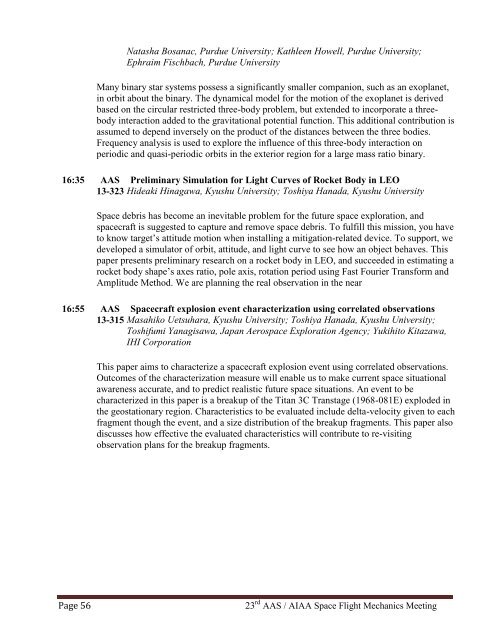meetings - Space Flight Mechanics Committee
meetings - Space Flight Mechanics Committee
meetings - Space Flight Mechanics Committee
Create successful ePaper yourself
Turn your PDF publications into a flip-book with our unique Google optimized e-Paper software.
Natasha Bosanac, Purdue University; Kathleen Howell, Purdue University;<br />
Ephraim Fischbach, Purdue University<br />
Many binary star systems possess a significantly smaller companion, such as an exoplanet,<br />
in orbit about the binary. The dynamical model for the motion of the exoplanet is derived<br />
based on the circular restricted three-body problem, but extended to incorporate a threebody<br />
interaction added to the gravitational potential function. This additional contribution is<br />
assumed to depend inversely on the product of the distances between the three bodies.<br />
Frequency analysis is used to explore the influence of this three-body interaction on<br />
periodic and quasi-periodic orbits in the exterior region for a large mass ratio binary.<br />
16:35 AAS Preliminary Simulation for Light Curves of Rocket Body in LEO<br />
13-323 Hideaki Hinagawa, Kyushu University; Toshiya Hanada, Kyushu University<br />
<strong>Space</strong> debris has become an inevitable problem for the future space exploration, and<br />
spacecraft is suggested to capture and remove space debris. To fulfill this mission, you have<br />
to know target’s attitude motion when installing a mitigation-related device. To support, we<br />
developed a simulator of orbit, attitude, and light curve to see how an object behaves. This<br />
paper presents preliminary research on a rocket body in LEO, and succeeded in estimating a<br />
rocket body shape’s axes ratio, pole axis, rotation period using Fast Fourier Transform and<br />
Amplitude Method. We are planning the real observation in the near<br />
16:55 AAS <strong>Space</strong>craft explosion event characterization using correlated observations<br />
13-315 Masahiko Uetsuhara, Kyushu University; Toshiya Hanada, Kyushu University;<br />
Toshifumi Yanagisawa, Japan Aerospace Exploration Agency; Yukihito Kitazawa,<br />
IHI Corporation<br />
This paper aims to characterize a spacecraft explosion event using correlated observations.<br />
Outcomes of the characterization measure will enable us to make current space situational<br />
awareness accurate, and to predict realistic future space situations. An event to be<br />
characterized in this paper is a breakup of the Titan 3C Transtage (1968-081E) exploded in<br />
the geostationary region. Characteristics to be evaluated include delta-velocity given to each<br />
fragment though the event, and a size distribution of the breakup fragments. This paper also<br />
discusses how effective the evaluated characteristics will contribute to re-visiting<br />
observation plans for the breakup fragments.<br />
Page 56<br />
23 rd AAS / AIAA <strong>Space</strong> <strong>Flight</strong> <strong>Mechanics</strong> Meeting
















